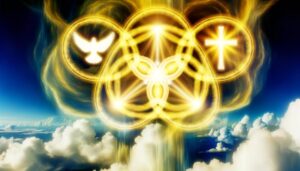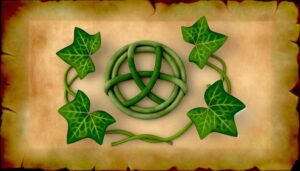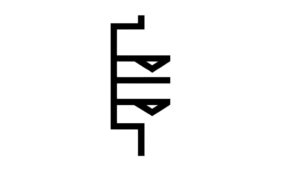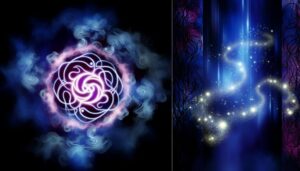Celtic Mother and Daughter Symbol Meaning?
The Celtic Mother and Daughter Symbol, deeply rooted in Celtic mythology and ancient traditions, signifies the revered maternal lineage and familial bonds through intricate and powerful motifs. These symbols, often found in carvings, jewelry, and pottery, emphasize the cyclical nature of life and the continuity of wisdom across generations.
Designs commonly incorporate elements such as knots, spirals, and heart shapes to symbolize love, interconnectedness, and eternity. Modern interpretations maintain their cultural significance, integrating traditional iconography with contemporary aesthetics.
Such nuanced symbolism reflects ancient traditions and evolving cultural narratives, revealing a profound depth of meaning and continuity through time. Interested in the stories and artistic interpretations?
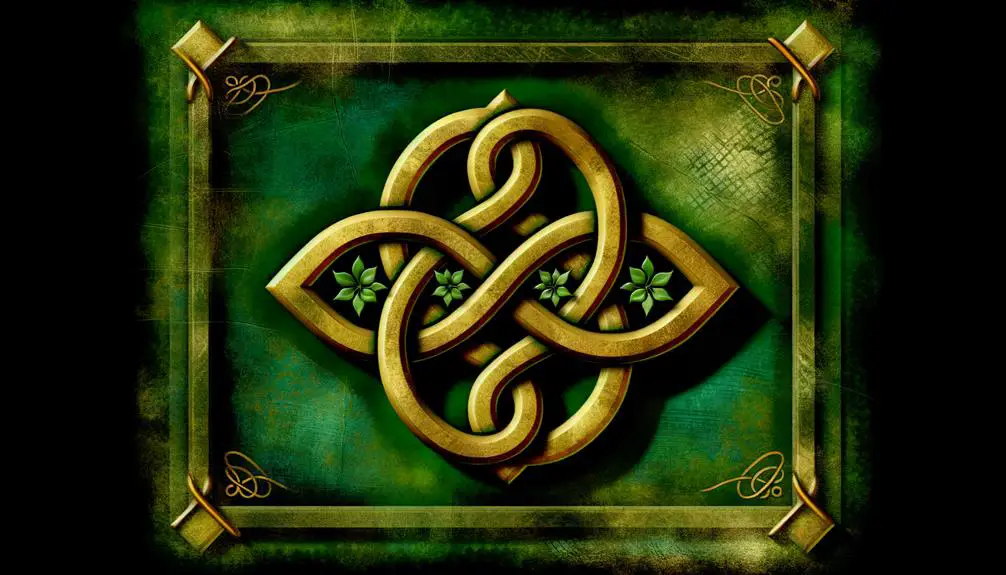
Key Takeaways
- The Celtic Mother and Daughter symbol represents the unbreakable bond and continuity between generations, deeply rooted in Celtic mythology.
- Common designs feature intricate knots, spirals, and heart shapes, symbolizing interconnectedness, eternity, and maternal love.
- Animal motifs like serpents, birds, and horses are embedded, reflecting virtues like rebirth, freedom, and strength within Celtic tradition.
- This symbol is popular in jewelry and tattoos, embodying familial devotion and cultural expression with aesthetic appeal.
- Modern interpretations maintain relevance in rituals and ceremonies, emphasizing themes of familial bonds, cultural identity, and heritage transmission.
Historical Origins
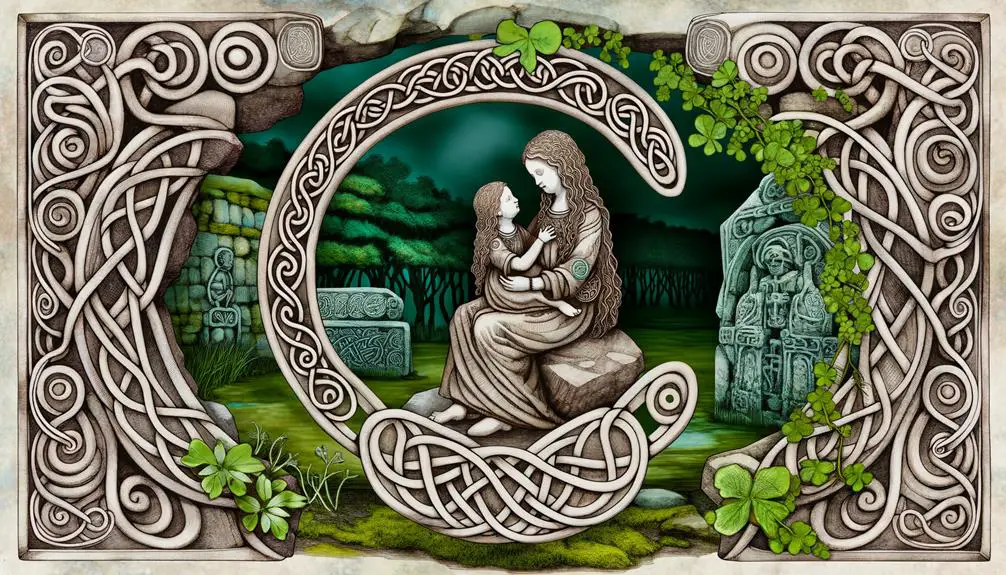
Emerging from the rich tapestry of Celtic mythology and iconography, the mother and daughter symbol finds its roots in ancient traditions that celebrate the profound bond between maternal figures and their offspring.
These symbols were typically manifested in intricate carvings, jewelry, and pottery, serving as tangible representations of familial unity. Historically, Celtic societies revered maternal lineage, often tracing ancestry through the maternal line, which underscores the cultural significance of this symbol.
Archaeological findings have revealed artifacts dating back to the Iron Age, adorned with motifs that emphasize this connection. These artifacts not only highlight the aesthetic attributes but also provide insights into the societal values and beliefs surrounding motherhood and familial continuity within the Celtic cultural framework.
Symbolic Meaning
The symbolic meaning of the Celtic mother and daughter motif is deeply intertwined with themes of fertility, nurturing, and the cyclical nature of life, reflecting the cultural emphasis on the interconnectedness of family and the perpetuation of lineage. This emblem encapsulates the essence of maternal bonds, portraying the daughter as an extension of the mother, thereby symbolizing continuity and growth. The following table elucidates key symbolic elements:
| Symbolic Aspect | Interpretation |
|---|---|
| Fertility | Generative power and life-giving force |
| Nurturing | Care, protection, and maternal guidance |
| Cyclical Nature | Seasons, life cycles, and eternal recurrence |
| Family Interconnectedness | Unity, heritage, and ancestral ties |
Such symbolism underscores the profound respect for familial connections and the integral role of women in sustaining cultural and biological heritage.
Cultural Significance
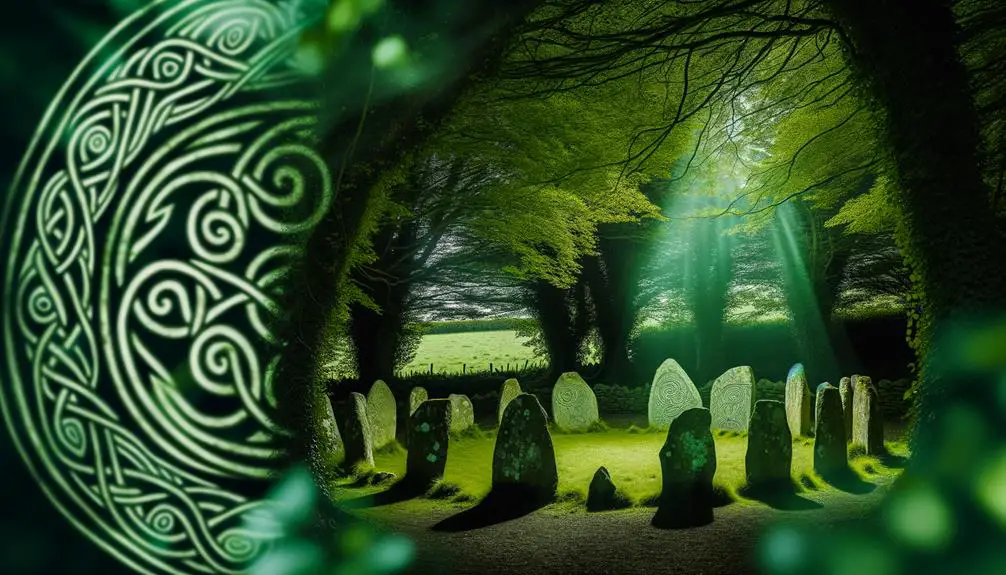
The cultural significance of the Celtic Mother and Daughter symbol is multifaceted, encompassing symbolic connections that articulate familial bonds and ancient traditions that have been meticulously preserved through generations.
These connections reflect the societal importance of maternal lineage and continuity within Celtic communities.
Moreover, modern interpretations have evolved, allowing the symbol to retain its relevance while adapting to contemporary cultural contexts.
Symbolic Connections Explained
Rooted in ancient traditions and imbued with profound meaning, the Celtic mother and daughter symbol serves as a powerful emblem of the intricate ties between maternal lineage and cultural identity.
This symbol, often depicted through interwoven knotwork, signifies the unbreakable bond and continuity between generations. It encapsulates the transmission of wisdom, values, and heritage from mother to daughter, fostering a shared sense of identity and belonging.
The intertwining design also represents the cyclical nature of life and the eternal connection within familial structures.
In a broader cultural context, this symbol underscores the reverence for matrilineal descent prevalent in Celtic societies, highlighting the essential role of women as bearers and preservers of cultural tradition.
Ancient Traditions Preserved
In examining the cultural significance of the Celtic mother and daughter symbol, one must consider the ancient traditions that have meticulously preserved its profound heritage through generations. These traditions have encapsulated the symbol's essence, embedding it within the fabric of Celtic society through various practices and narratives.
The symbol is not merely an artistic motif, but a repository of cultural values and familial bonds, reflecting the interconnectedness of lineage and heritage.
Key components of these traditions include:
- Oral Histories: Stories and myths passed down through generations.
- Rituals: Ceremonial practices reinforcing familial bonds.
- Artistic Expressions: Symbolism in artifacts, jewelry, and carvings.
- Festivals: Celebrations that honor maternal lineage and connections.
These elements collectively underscore the enduring legacy of the Celtic mother and daughter symbol.
Modern Interpretations Evolved
Evolving through the lens of contemporary society, modern interpretations of the Celtic mother and daughter symbol reveal a nuanced amalgamation of historical reverence and contemporary relevance. This emblem, once a sign of ancient kinship bonds, now resonates profoundly within today's cultural landscape, symbolizing enduring familial ties and maternal devotion.
| Historical Significance | Modern Cultural Relevance |
|---|---|
| Embraces ancient kinship | Represents enduring familial ties |
| Symbol of maternal dedication | Celebrated in jewelry and art |
| Rooted in Celtic mythology | Adapted in modern literature and media |
The symbol's adaptability underscores its timeless appeal, bridging centuries-old traditions with present-day expressions of familial love. As it continues to be celebrated in jewelry, art, and literature, the Celtic mother and daughter symbol remains a poignant reminder of the unbroken thread connecting past and present.
Common Designs
The common designs of the Celtic mother and daughter symbol are rich in cultural and artistic significance. These designs often incorporate intricate knots and spirals, emblematic heart shapes, and symbolic animal motifs, each carrying profound meanings related to familial bonds, continuity, and nature.
Analyzing these elements offers insight into the aesthetic and symbolic dimensions that these Celtic patterns embody.
Knots and Spirals
Among the myriad designs that characterize Celtic art, knots and spirals stand out as profound symbols of interconnectedness and eternity, often featured prominently in representations of the mother-daughter bond. These intricate patterns are not merely decorative but imbued with deep symbolic meanings that resonate with themes of unity and perpetuity.
- Trinity Knots: Symbolize the triadic nature of life, often interpreted as mother, father, and child.
- Spiral Patterns: Represent growth, evolution, and the eternal cycle of life, embodying the maternal bond.
- Eternal Knots: Indicate timeless connections and endless love, quintessential in mother-daughter symbolism.
- Double Spirals: Depict balance and duality, emphasizing the harmonious relationship between mother and daughter.
These motifs encapsulate the enduring and cyclical nature of familial connections.
Heart Shapes
In the domain of Celtic artistry, heart shapes frequently manifest as powerful symbols of love and affection, particularly within the context of mother-daughter relationships. These designs often integrate intricate patterns, embodying the eternal bond between generations. The following table illustrates common heart-shaped motifs and their symbolic nuances:
| Design Element | Symbolic Interpretation |
|---|---|
| Interwoven Hearts | Unity and interconnectedness |
| Double Hearts | Mutual love and duality |
| Heart with Knot | Eternal love, strength, and commitment |
These heart shapes, often adorned with additional Celtic elements such as knots and spirals, emphasize continuity and unending love. The careful craftsmanship in these designs reveals a deep cultural appreciation for familial bonds, particularly emphasizing the unique and enduring connection between mothers and daughters.
Animal Motifs
Animal motifs, prevalent in Celtic artistry, serve as profound representations of various virtues and characteristics, often embodying cultural beliefs and mythological significance. These intricate designs are not mere decorations but carry deep symbolic meanings that resonate with the Celtic worldview.
Key animal motifs include:
- Serpents: Symbolize rebirth, transformation, and healing, often associated with the cycle of life and death.
- Birds: Represent freedom, transcendence, and the connection between the earth and the spiritual domain.
- Horses: Emblematic of strength, endurance, and sovereignty, frequently linked to warrior culture and nobility.
- Fish: Denote wisdom, knowledge, and the mysterious depths of the subconscious.
These motifs intricately weave cultural narratives into visual art, reinforcing the spiritual and communal aspects of Celtic tradition.
Artistic Interpretations
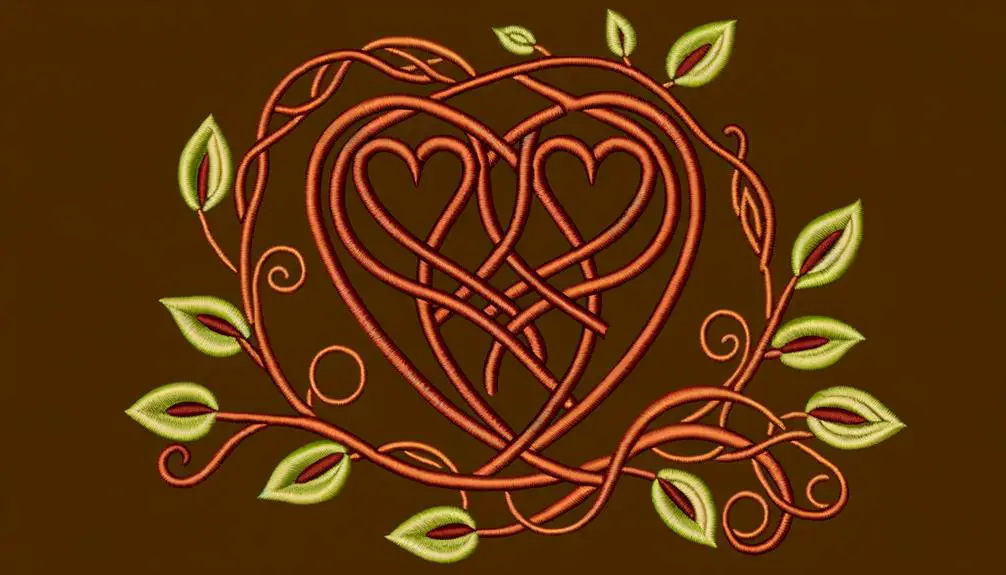
Artistic interpretations of the Celtic Mother and Daughter symbol often reveal a profound interplay between ancient cultural narratives and contemporary aesthetic sensibilities. These representations frequently incorporate intricate knotwork and spirals, emblematic of the Celts' reverence for interconnectedness and cyclical nature.
Artists leverage these motifs to evoke themes of maternal protection, continuity, and the passage of wisdom through generations. By blending traditional iconography with modern artistic techniques, creators make sure that the ancient symbol resonates with contemporary audiences. This synthesis not only preserves cultural heritage but also allows for a dynamic reinterpretation that reflects evolving societal values.
As a result, the symbol remains a vivid testament to the enduring power of Celtic artistry and its ability to adapt and thrive within diverse artistic paradigms.
Symbol in Jewelry
Building on the rich interplay between ancient narratives and contemporary aesthetics, the Celtic Mother and Daughter symbol has found a prominent and meaningful expression in the world of jewelry design. This emblem, steeped in historical resonance, serves as a poignant representation of familial bonds, particularly the maternal connection.
Jewelry artisans have adeptly integrated this symbol into various forms, creating pieces that are both visually enchanting and deeply symbolic.
- Pendant Necklaces: Often crafted in sterling silver or gold, these pieces highlight intricate knotwork.
- Bracelets: Incorporating the symbol into charm bracelets offers a modern touch.
- Earrings: Delicate designs provide an elegant way to wear the emblem daily.
- Rings: Symbolic engravings within bands signify enduring connections.
Such jewelry pieces provide tangible connections to Celtic heritage and personal significance.
Tattoos and Body Art
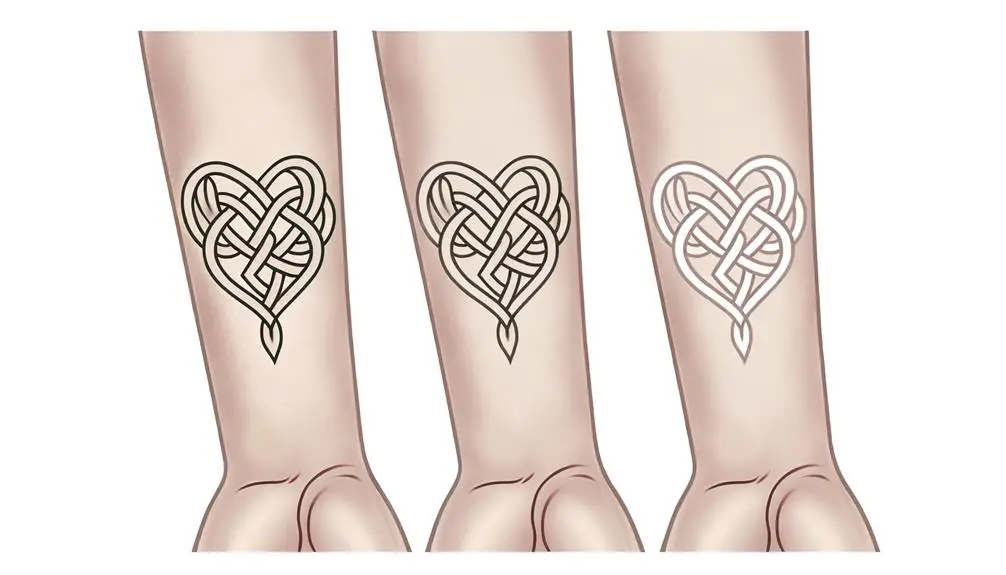
In the domain of tattoos and body art, the Celtic Mother and Daughter symbol serves as a profound and enduring manifestation of maternal bonds, encapsulating both cultural heritage and personal significance.
This symbol, often intricately designed with interwoven knots and spirals, represents the unbreakable connection between mother and daughter, echoing themes of eternity and continuity.
The permanence of a tattoo imparts an additional layer of meaning, transforming the symbol into a lifelong statement of love and unity. Besides, the aesthetic appeal of Celtic art, characterized by its intricate patterns and historical resonance, enhances its desirability in contemporary tattoo culture.
Therefore, this symbol not only embodies familial devotion but also acts as a medium for cultural expression and personal identity.
Modern-Day Usage
The contemporary relevance of the Celtic Mother and Daughter symbol extends beyond its traditional and aesthetic roots, finding a place in various modern cultural practices and personal expressions. This emblem, imbued with themes of familial bonds and continuity, has permeated diverse facets of contemporary life.
- Jewelry and Fashion: The symbol is often incorporated into necklaces, bracelets, and clothing, serving as a tangible representation of maternal connections.
- Home Décor: Artisans and designers frequently use the motif in home décor items such as wall art and tapestries to evoke a sense of heritage and unity.
- Digital Media: Social media platforms and digital art have embraced the symbol, allowing for widespread sharing and reinterpretation.
- Ceremonial Uses: The symbol finds its place in modern rituals and ceremonies, celebrating maternal relationships.
Stories and Legends
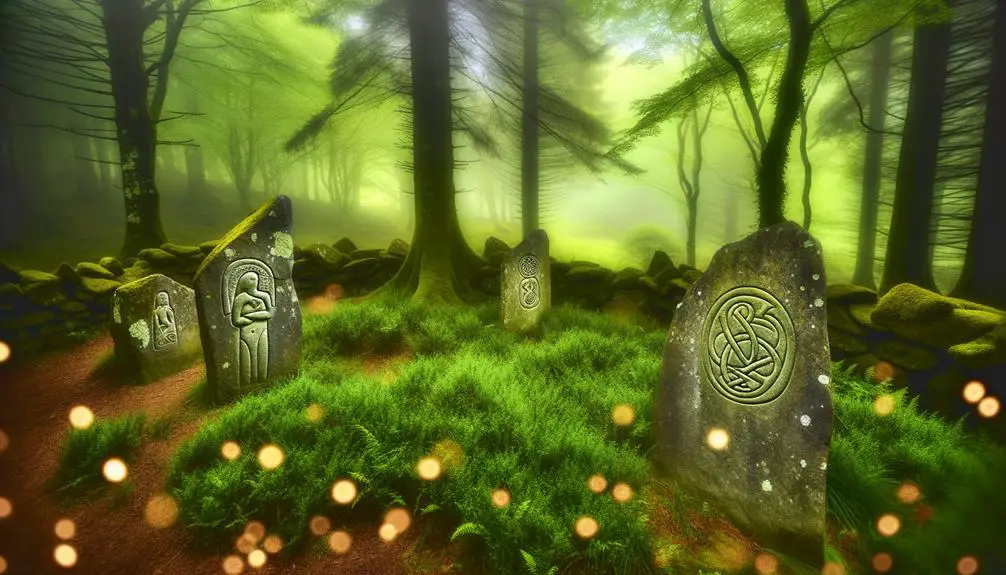
Countless stories and legends surround the Celtic Mother and Daughter symbol, each narrative enriching its cultural and historical significance within Celtic mythology.
Central to these tales is the depiction of the mother-daughter bond as a fundamental, unbreakable force. One prominent legend involves the goddess Danu, often considered the mother of the gods in Celtic lore, nurturing her offspring and ensuring the continuity of divine wisdom through generations.
Another tale speaks of the seasonal cycle, embodied by a mother goddess and her daughter, representing life, death, and rebirth. These stories not only underscore maternal devotion but also highlight themes of fertility, protection, and the cyclical nature of existence, thereby embedding the symbol deeply in the social and spiritual fabric of Celtic society.
Comparing Symbols
In examining the Celtic mother and daughter symbol, it is essential to analyze the differences in symbolic meanings, which may vary greatly across different regions and time periods.
Furthermore, a comparison of the historical contexts in which these symbols emerged provides deeper insights into their cultural significance.
Besides, variations in artistic styles highlight the evolution of these symbols, reflecting broader shifts in aesthetic and societal values.
Symbolic Meaning Differences
A thorough examination of the symbolic meaning differences between various Celtic mother and daughter symbols reveals distinct cultural narratives and values embedded within each representation. These symbols, often intricate and rich in meaning, communicate a diversity of themes that are central to Celtic heritage.
Key symbolic differences include:
- Interwoven Knot Designs: Emphasize the unbreakable bond and eternal connection between mother and daughter.
- Triple Spiral (Triskele): Represents growth, progress, and the cyclical nature of life, often linking to maternal wisdom.
- Tree of Life: Symbolizes the nurturing aspect of motherhood and the growth of the daughter as an extension of the mother's legacy.
- Celtic Cross: Reflects a blend of spiritual and earthly connections, highlighting the protective and guiding role of the mother.
These symbols collectively portray a nuanced and multifaceted understanding of maternal relationships within Celtic culture.
Historical Context Comparison
Historical context provides a profound understanding of how Celtic mother and daughter symbols evolved, reflecting the socio-cultural dynamics and values of different periods within Celtic history. Early Celtic societies, characterized by kinship-based communities, revered familial bonds, which is evident in the prominence of maternal imagery. These symbols, often intertwined with nature motifs, underscored the nurturing and protective roles of women.
In contrast, later periods witnessed the integration of Christian iconography, where the symbolism began to amalgamate with depictions of the Virgin Mary, indicating a shift towards spiritual motherhood. The comparative analysis of these symbols across timelines reveals both continuity and transformation, illustrating how external influences and internal societal changes jointly shaped Celtic iconographic traditions.
Artistic Style Variations
Analyzing the artistic style variations of Celtic mother and daughter symbols reveals a nuanced interplay between evolving cultural aesthetics and the enduring significance of maternal representation. These symbols, often depicted through intricate knotwork and interwoven designs, encapsulate a rich tapestry of artistic evolution.
Variations arise due to regional influences, historical periods, and artistic mediums, each contributing to the distinctiveness observed within these symbols.
- Knotwork Complexity: The level of intricacy in knotwork can indicate the era and regional craftsmanship.
- Symbolic Integration: Variations in how symbols like the Triskelion or Tree of Life are incorporated.
- Material Usage: Differences in mediums, such as stone carvings versus metalwork.
- Cultural Syncretism: Influences from interactions with other cultures, like Norse or Roman, reflected in design elements.
Such variations underscore the dynamic nature of Celtic art and its cultural significance.
How to Choose
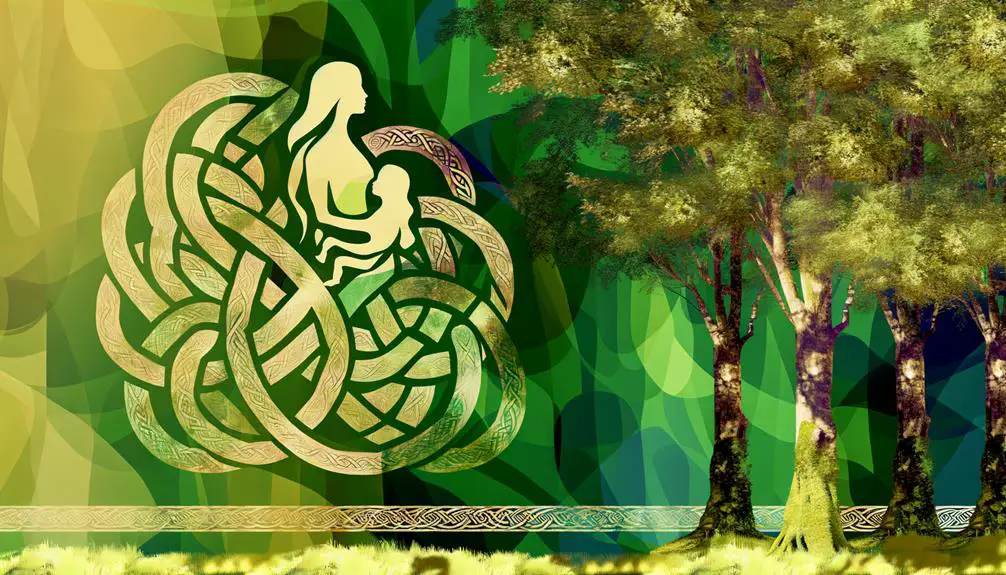
Selecting an appropriate Celtic mother and daughter symbol requires a thorough understanding of the various designs and their unique cultural and historical significances. Potential choices range from the intricate Knotwork, embodying interconnectedness and eternity, to the Triquetra, symbolizing the trinity of mind, body, and spirit.
It is important to take into account the specific attributes you wish to emphasize, such as protection, unity, or eternal bonding. Additionally, the aesthetic appeal of each design should align with personal preferences and the intended display context, whether it be jewelry, artwork, or tattoos.
Conclusion
The Celtic mother and daughter symbol stands as a timeless attestation to the enduring bond between generations, intricately woven with historical roots, profound meanings, and rich cultural significance.
Through its varied designs and artistic interpretations, this emblem encapsulates stories and legends, bridging the past and present.
Modern-day usage breathes new life into this ancient motif, ensuring its legacy endures.
Ultimately, the symbol serves as a poignant reminder of the unbreakable familial ties that transcend time and tradition.

